History of the House / 1927 to 1930 - Dr Ella Webb
Previous / Next: 1924 to 1927 - Robert Rooney / 1930 to 1945 - Sir John Lumsden
See also: Dr. Ella Webb's 1916 Easter Rising Diary | Dr. Ella Webb and the Magdalen Asylums | Articles in books
Earlscliffe Residents 1927 to 1930
After Robert Rooney had rented the property out for a number of years, in 1927, Earlscliffe returned to being lived in by a member of the Ovenden family when Ella Webb, the eldest daughter of the Very Rev Charles Thomas Ovenden moved in.
Dr Ella Webb
Family History
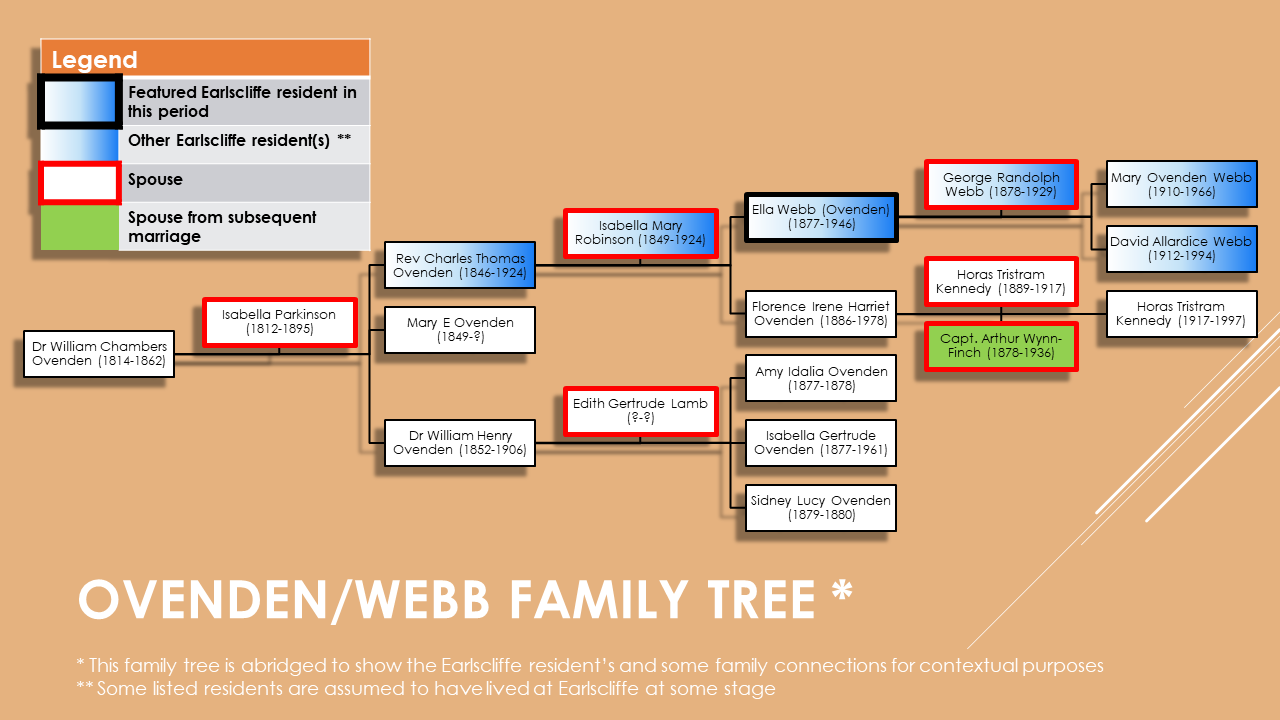
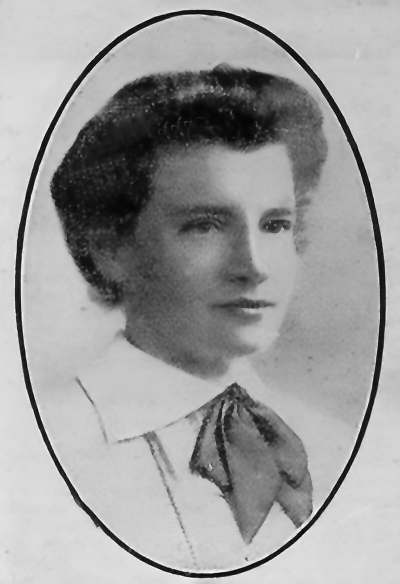
Isabella (Ella) Gertrude Amy Ovenden, the daughter of the Very Rev. Charles Thomas Ovenden, the Dean of St. Patrick's Cathedral in Dublin, was born on 16 October 1877 and was educated at Alexandra School, Dublin, Queen's College, London, and at Göttingen, Germany.
At the age of 18 she surprised her parents by wanting to become a doctor. They suggested that she study natural science first, which she did, and graduated with honours from the Royal College of Science in 1899.
She still wanted to be a doctor, so enrolled at the Cecilia Street School, attending clinical teaching at the House of Industry Hospitals (later renamed Richmond Hospital). She graduated with first place in 1904 from the Royal University of Ireland (the first female student to achieve first place in the final medical examinations of the Royal). At the time, the Catholic University Magazine, St. Stephen's, stated that:
[it] was a record to gain it over the heads of so many competitors of the sterner sex, which, until recent years, regarded medicine as exclusively its own ground. [1]
-"St. Stephen's", Catholic University Magazine 1904
This was all achieved before Trinity College decided to accept women students for the first time in 1904! [2] Even by 1918, fewer than 100 women were trained and qualified as doctors in Ireland. [3]
Ella was awarded a Master's in Medicine in 1906 and, with it, won a prestigious travelling scholarship where she ended up studying in Vienna.
Returning to Dublin, in 1907, she wrote an article for a publication called "Open Doors for Irishwomen", a guide to the professions opened to educated women in Ireland. In the article she outlined the qualities needed by any woman wanting to become a doctor. She thought that the love of the work was the most important. However, she said that the medical profession, especially for women, was not one that gave quick returns. She said that
...prospects are improving every year, as the woman doctor takes a more established place in the community, but her position will only be secure as she shows that she has taken up medicine, not as a fad, but as a serious scientific or philanthropic undertaking. [4]
-Ella Webb 1907
In December 1907 she married George Randolph Webb, a Fellow of Trinity College Dublin (FTCD) [5] They moved into Hatch Street in Dublin where she combined raising her family with running a private practice, along with a free evening dispensary in Kevin Street. [2]
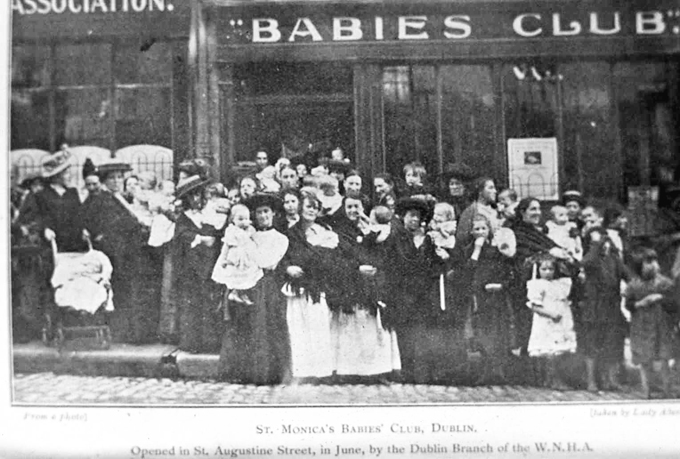
Medical work
Over the next number of years, Dr Ella Webb performed a combination of clinical and teaching roles and was active in the Women's National Health Association, which had been set up in 1907 by lady Aberdeen, wife of the Lord Lieutenant of Ireland. This organisation looked at ways to eradicate tuberculosis, and opened healthcare centres. [3]
Babies Clubs
She also had a particular focus on the health of children. In 1909 she did voluntary work in at least two 'Babies Clubs' in Dublin, including St Monica's Babies Club. These clubs looked at preventative approaches to health, including holding classes on cookery, sewing, and home hygiene.
As an example of the work they did at these clubs, by 1913, St. Monica's Babies club had seen up to 1,000 babies since it opened, teaching their mothers how to care for their own health and that of their babies. A trained nurse also visits the mothers at their own homes and a doctor (such as Webb) attends on club days. [6]
Breastfeeding
Ella was also a strong believer in the importance of breastfeeding and promoted it strongly. [3]
In 1913 she published an analysis of 200 mothers in her own practice who had commenced to breastfeed but then abandoned it. In the report she said:
We are too ready to say 'This woman cannot nurse her infant, let us seek the best possible substitute on which to feed it', instead of saying 'This woman cannot nurse her infant, let us seek to discover why, and remedy that effect'.
-Ella Webb 1913 [3] [4]
Infant mortality
As part of her academic work, Dr Webb studied mortality among children in Dublin under one year old, which was abnormally high in the city of Dublin. [7] In 1915, in the Dublin area, there were 160 deaths per 1000 infants under one years of age. Compare this with Cork (119), Belfast (137), Liverpool (132), and London (112). [7]
Statistics like these spurred Dr Webb and others on to do pioneering work in preventative approaches to medicine with children and Ella continued this focus on children throughout her career. [8]
As an example of this good work, Webb was part of the Dublin Committee for the Prevention of Infantile Mortality. In 1913, they held their annual meeting, presided by Ella Webb's father, Charles Thomas Ovenden, the Dean of St Patricks. The annual report stated that 200 ladies worked as voluntary health visitors as part of the committee, and between them, had paid 22,500 visits to mothers and their children during the year. These health visitors were all trained by Dr Ella Webb.
During the meeting, the Dean gave an account of his own experience in visiting the homes of poor people and the hardships they suffered, especially the mothers and children. As an example, he spoke of one room he visited where he saw a girl 'dying of consumption in a bed', whilst under the bed, her healthy brother had to sleep all year round.
The work that Webb did for this committee was praised at the meeting, especially the good work she did at training people, regularly attending every meeting, and for her ability to keep the spirits high with her cheerful words and actions. [9]
St John Ambulance Brigade
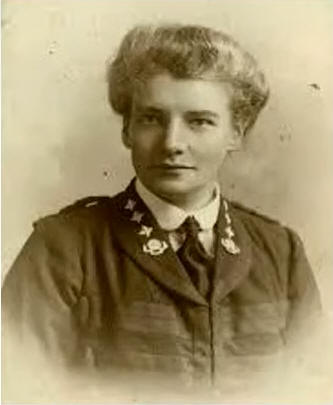
The St John Ambulance Brigade in Ireland was founded in 1903 by Dr (later Sir) John Lumsden who was the Chief Medical Officer of the Guinness Brewery at the time. He had identified a need within the Guinness brewery to have trained first aiders on site to manage work-related medical incidents. Within a short space of time the numbers trained had swelled and he used these growing ranks to form the St John Ambulance Brigade.
Dr Ella Webb joined the brigade, around 1904 after she qualified as a doctor.
In June 1916, Dr Ella Webb was made a Lady of Grace of the Order of St John of Jerusalem. The following brief summary of her St. John Ambulance career to date was announced in the Weekly Irish Times at that time:
She has given since 1904 about 50 courses of lectures in First Aid, Home Nursing, Sanitation and Hygiene, and also junior courses. Elected life member, 1912, examiner 1914. Made Divisional Surgeon to the City of Dublin Nursing Division, 1911; Lady Corps Superintendent, August 1914; Lady District Superintendent, October 1914. Since the beginning of the war Dr Webb has given great help in administrative work of the No. 12 District in organising new divisions and inspections.
-"Dr Ella Webb, Lady of Grace", Weekly Irish Times, Jun 17th 1916 [10]
She was also a member of the Joint Committee of the British Red Cross Society. [11]
Easter rising 1916
During the Easter Rising in 1916 Ella Webb was on duty as Lady District Superintendent of the St. John Ambulance Brigade and, seeing the situation escalate, was involved with providing important medical support right from the start.
As the conflict intensified, the number of casualties rose, putting the existing Dublin city hospitals under pressure. Webb therefore decided to set up a series of temporary field hospitals around Dublin.
The first was in 40 Merrion Square and was set up within a couple of hours, with the first emergency operation (an amputation) taking place in this field hospital within an hour of being ready.
In all, she set up a total of seven auxiliary hospitals across the city, each with a medical team and 'porters' to bring in the wounded.
In terms of medical staff, Webb managed to get the services of a number of local doctors, including Sir Robert Woods (the father of Dr Robert Rowan Woods, who went on to own and live in Earlscliffe in the 1950s).
These auxiliary hospitals filled up quickly. Even so, the main Dublin city hospitals soon realised it was sometimes better to take the wounded out of their overstretched facilities and transfer them into the hospitals set up by Ella Webb, such was the reputation of the good work they were doing.
Each day during the uprising, Ella would cycle through the firing line to visit the field hospitals and, over the period, she offered her services to both sides of the conflict and managed to save the lives of many people. [12]
In January 1917, Ella Webb was awarded a silver medal in England for her services during the rising by the Grand Priory of the Order of the Hospital of St. John of Jerusalem . At the ceremony Sir Henry Blake said the following:
With regard to Dr. Mrs. Ella G. Webb — (applause) — she helped to organise emergency hospitals, was on duty during the entire period of the rising, bicycled through the firing line each day, visiting hospitals, ascertaining their needs and beating up workers; travelled in ambulance waggons to the hospital during the most critical period, and at considerable personal risk.
-Sir Henry Blake, 16th Jan 1917 [13]
Dr Ella Webb was made a Lady of Grace of the Order of St John of Jerusalem and was later awarded the MBE in 1918 for her medical work during the Easter Rising.
For more details, see the timeline following Dr Ella Webbs Easter Rising Diary.
Adelaide Hospital
Dr Ella Webb was appointed as an anaesthetist to the Adelaide Hospital in 1918. As such, she was the first woman member of the medical staff at the Adelaide Hosiptal, and was a role model for many women after her. [2]
In addition to this role, Webb ran a children's clinic in the hospital where she placed great emphasis on reviewing the social circumstances for the child in order to prevent future medical problems. This led to her looking for help in this area.
Medical Social Worker
To enhance her ability to address the social circumstances surrounding the children under her care, Ella Webb took a pioneering step by appointing the first Medical Social Worker (then known as an Almoner) in Ireland. In 1919, during a meeting of the Red Cross Society in Dublin, she sought the assistance of a Voluntary Aid Detachment (VAD) for the dispensary she had established for sick children at the Adelaide Hospital the previous year.
Responding to Ella Webb's call, Miss Winifred Alcock, who was undergoing Almoner training in London, volunteered her services and began working alongside Dr. Webb. Over three years of dedicated service, Miss Alcock recognised the growing need for more substantial support and put forth a request for a full-time salaried assistant. [14] As a result of her initiative, Miss Olive Crawford was appointed as the first qualified Almoner.
This was the beginning of social work in the Irish hospital system. [15] Ella Webb's foresight and initiative, coupled with the dedication of Miss Alcock and subsequent appointment of Miss Crawford, laid the foundation for the integration of social work services into healthcare institutions. Their collective efforts represented the dawn of a new era in caring for the well-being of patients beyond their medical needs, acknowledging the importance of addressing social factors that impact their health and recovery.
St. Ultan's
Webb was a close colleague of Dr Kathleen Lynn [5], and Dr Dorothy Stopford Price [2] who, in 1918, were in the process of procuring 37 Charlemont Street in Dublin to set up a paediatric hospital. However, before they had time to convert it into a children's hospital, the 'flu. pandemic broke out, putting everything on hold. [16]
In 1918, the so-called Spanish 'flu. was fast becoming the most deadliest pandemic of the 20th century. It affected some 800,000 people in Ireland and killed about 23,000. [17]
However, the hospital, St Ultan's, founded by Kathleen Lynn and Madeleine ffrench-Mullen, was finally opened in 1919 and became a celebrated children's hospital. The hospital was named St Ultan's after the seventh century Saint Ultan of Ardbraccan, abbot bishop of Meath, who had fed, clothed and educated around 500 orphaned children of Meath during an outbreak of buide-connaill or yellow plague which swept through Ireland. [18]
'Social' medicine
Whilst working at both the Adelaide Hospital and at St. Ultan's, Webb had to treat many cases of rickets in children. She believed that the poor living conditions that these children lived in, along with inadequate diet, resulting in malnutrition. was a major factor in causing their medical conditions. She later wrote about the patients that she saw at Adelaide:
There is a great deal of poverty and starvation, among the families who come, and a large proportion of the diseases seen are directly or indirectly due to this cause.
-Ella Webb [2]
Unlike many doctors at the time, Webb was a great believer in 'social' medicine. She knew that gastroenteritis in infants, rickets in older children, and tuberculosis at all ages, were products of the living conditions in 1920s Dublin, and it was the women doctors, especially those at St. Ultan's, that were at the frontline having to deal with these conditions. As David Mitchell said in his book, "A ‘Peculiar' Place: The Adelaide Hospital, Dublin 1839-1989":
Kathleen Lynn, Ella Webb, Dorothy Stopford-Price and others were the pioneers of preventative medicine in Dublin.
-David Mitchell, "A 'Peculiar' Place: The Adelaide Hospital, Dublin 1839-1989" [2]
This 'social' element was later proved to be true and this was an important influence on much of the future approach to medicine.
Treatment of rickets
In her clinics, Webb was treating many cases of rickets amongst the children. She want to do more, but the political situation in Ireland in 1922 was hampering her efforts.
The signing of a peace treaty with the Irish nationalists and Britain had created the Irish Free State but this resulted in civil war in Ireland.
It was at this time that Ella Webb stated:
I don't care what state the country is in. Children need help, and I am going to help them.
-Ella Webb 1922 [4] [19]
By the early 1920s, sunlight was found to be major factor in the prevention and healing of rickets. In 1923 it was discovered that ultraviolet (UV) light from lamps could be used to increase the benefits.
Webb began to use this form of treatment at her clinic. However, she knew that many of the children she saw with rickets lived in the dark and overcrowded tenement slums of Dublin. Although she could treat them occasionally in the clinics, these children needed more exposure to sunlight, plus better food than what they may have been getting at home.
In 1924, Webb started a major fundraising effort and, with the help of her friend, Letitia Overend, built a specialised home in Stillorgan which had two wards, each with south-facing verandas. The home, named the Children's Sunshine Home, was opened on St Patrick's day 1925. Here she could provide medical care within a residential setting where children with rickets could be treated with 'sunshine', supplemented with UV lamps to help them to fully recover before returning to their own homes.
In 2006 the Sunshine home was merged with the LauraLynn, Ireland's Children's Hospice. [20]
Other preventative medicine
Dr Webb continued to do further pioneering work in preventative medicine with children to try to reduce infant mortality. [8] For instance, she became famous for prescribing a teaspoonful of Guinness for infants recovering from gastroenteritis (once they were over the worst of the illness)! [2]
Controversy over comments about 'illegitimate' children in care
From the actions that Dr Ella Webb performed throughout her career, she was, in no doubt, a women who cared for children, devoting her whole life to this activity. However, she lived and worshipped in a country that was deeply religious and had strong views on so called 'illegitimate' children. [21] Webb's views back in 1924 on the way society looked at these children, and the care provided to them by institutes such as Magdalen Laundries or Asylums has been causing some debate recently. See the following for more information:
Move to Earlscliffe
Following the death of their parents in 1924, Ella's younger sister, Florence, assumed the responsibility of renting out Earlscliffe. Nevertheless, in March 1927, the house found its way back into the loving embrace of the Ovenden family as Ella, along with her husband George, son David Allardice, and daughter Mary Ovenden Webb, decided to make it their new summer home. [22]
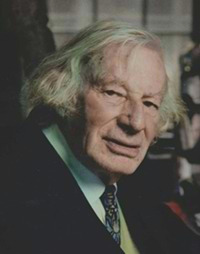
David Allardice
David was 15 when the family moved into Earlscliffe; an impressionable age for a young man! We wonder if it was the wonderful plant life in and around Earlscliffe that encouraged David to study Botany?
He graduated at Trinity College Dublin in 1935 in Natural Sciences (like his mother) and later gained a PhD at Trinity College, Cambridge. He later returned to Dublin to become assistant to the Professor of Plant Biology at Trinity College, Dublin, a post he was later awarded in 1949. [23]
David became widely respected for his classification of plants when he wrote the book "An Irish Flora"; a standard textbook that was revised many times and still remains an authority on the flora of Ireland today. [24]
David lived to 82 years of age and died in September 1994. [25]
Death of George Webb
Back in 1929, however, Ella Webb's husband, George, passed away at Earlscliffe [26] and was buried in St. Fintan's Cemetery in Sutton, Co. Dublin. [27]
The loss of George was undoubtedly a difficult chapter for Ella and her loved ones, leaving behind cherished memories and a void that could never be filled. And, although Dr Webb got immense pleasure from the gardens at Earlscliffe, [28] she eventually moved out to Rathgar, Dublin [29] and Earlscliffe was sold to a colleague and close friend of hers, the Vice Chairman of the British Red Cross Society and the Order of St John of Jerusalem, Sir John Lumsden. [29]
Death of Ella Webb
Dr Webb continued her medical work at St Ultan's and in the Sunshine Home, plus her volunteer work at St John Ambulance right up until she died on August 24,1946 at the age of 69. She is buried with her husband, George, in St. Fintan's Cemetery in Sutton, Co. Dublin, Section: L Grave No: 17. [30] [31]
Further information
The following is a link to a timeline following Dr Ella Webb's Easter Rising Diary plus .
•
•
•
List of Earlscliffe Residents
References
- [1] St. Stephen's, Nov 1904 page 111, as quoted in the book "Kathleen Lynn, Irishwoman, Patriot, Doctor", Margaret Ó hÓgartaigh, Publisher Irish Academic Press, 2006 ISBN 0-7165-2843-6
- [2] From the book 'A ‘Peculiar' Place: The Adelaide Hospital, Dublin 1839-1989", David Mitchell, 1990, Blackwater Press, ISBN 0 905471 16 4
- [3] As written in an article about Ella Webb by the College of Anaesthesiologists of Ireland https://www.anaesthesia.ie/latest-news/ella-webb-1877-1946/
- [4] As quoted in the lecture "Dr Ella Webb (1877 - 1946): St Ultan's … and more" by retired Paediatric Anaesthetist Dr Declan Warde for the Royal College of Physicians of Ireland, published on 20th Nov 2019. https://www.youtube.com/watch?v=yG24m1QbEvY
- [5] From the book "Kathleen Lynn, Irishwoman, Patriot, Doctor", Margaret Ó hÓgartaigh, Publisher Irish Academic Press, 2006 ISBN 0-7165-2843-6.
- [6] As reported in the Weekly Irish Times, 27th November, 1913, page 9.
- [7] Journal Of The Statistical And Social Inquiry Society Of Ireland. Part XCVII. President's Address, Infant Mortality And The Notification Of Births Acts, 1907, 1915 by William Lawsoist, LL.D., President http://www.tara.tcd.ie/bitstream/2262/4277/1/jssisiVolXIII479_497.pdf and Annual report of Marriages, Births and deaths Registered in Ireland 1915 https://www.nisra.gov.uk/sites/nisra.gov.uk/files/publications/1915.pdf
- [8] As mentioned in the Statutory Instrument No. 228 of 1996 from the Irish Statute Book, http://www.irishstatutebook.ie/ZZSI228Y1996.html
- [9] As reported in the Irish Times, 22nd February 1913, page 8.
- [10] "Dr Ella Webb, Lady of Grace": Women's Work in Ireland, Weekly Irish Times, 17th June 1916, page 6
- [11] Letter to the President of the Council of the Irish Free State from Sir John Lumsden, British Red Cross Society and the Order of St John of Jerusalem, Vice Chairman, Joint Committee, Leinster, Munster and Connaught, 10 December 1923
- [12] Published as Dr Ella Webb's diary in the Weekly Irish Times. The date on the publication is April 29th 1916, but this cannot be correct as the diary entries themselves go up to Monday May 1st 1916! There was an apology about publishing these clearly personal diary entries in the following weeks Weekly Irish Times, which was dated 20th May 1916. Hence it is assumed that the actual date of the original publication was 13th May 1916, which makes more sense. Also, see Padraig Allen's article in the Irish Times, March 27th 2016. https://www.irishtimes.com/life-and-style/health-family/st-john-ambulance-and-the-easter-rising-1.2583272
- [13] "The Dublin rebellion: ambulance workers' awards: gratifying presentations", Weekly Irish Times, 20th January 1917, page 4
- [14] As told in the book "Social work in Ireland: historical perspectives.", Noreen Kearney, Caroline Skehill, Institute of Public Administration, 2005 ISBN 1904541232, 9781904541233
- [15] As recounted in "The Adelaide Hospital, Dublin, 1839-2008", Dr Fergus O'Ferrall, Read to the Old Dublin Society, February 20th 2008
- [16] As discussed in "Close News", the newsletter from Saint Patrick's Cathedral, May 2020 as seen here: https://www.stpatrickscathedral.ie/wp-content/uploads/2019/09/Close-News-May-2020-6.pdf on 2nd Nov 2021.
- [17] https://www.ucd.ie/vetmed/about/alumni/alumninewsletter-may2020/fromthearchivesthespanishflupandemic1918-1919/
- [18] From the Library Ireland as seen here https://www.libraryireland.com/SocialHistoryAncientIreland/III-XXVI-10.php
- [19] As quoted in "An Irishwomen's Diary", Irish Times, 30th Jan 1953.
- [20] For details of the LauraLynn hospice see https://ww.lauralynn.ie/our-history
- [21] Final Report of the Commission of Investigation into Mother and Baby Homes, 12th January 2021 https://www.gov.ie/en/publication/d4b3d-final-report-of-the-commission-of-investigation-into-mother-and-baby-homes/
- [22] Irish Times, Court and Personal, March 5th 1927 page 6.
- [23] "New Professor", Irish Times, Nov 10th, 1949 page 5.
- [24] "An Irish Flora", D A Webb, 1943, Dundalgan Press, ISBN: 0852211317
- [25] Obituary: Professor David Webb, The Independent, 11th October 1994. See http://www.independent.co.uk/news/people/obituary-professor-david-webb-1442250.html
- [26] An obituary for Mr G. R. Webb, M.A., F.T.C.D. appeared in the Irish Times August 17, 1929
- [27] Ireland Genealogy Projects Archives Dublin Headstones. See http://www.igp-web.com/IGPArchives/ire/dublin/photos/tombstones/dublin-st-fintans-webb/index.html also http://buried.fingal.ie/wp-assets-bif/uploads/register-scans/St_Fintans_1_025.jpg
- [28] "Dr Ella Webb An Appreciation", Irish Times, Aug 27th 1946 page 5.
- [29] Actually, the house was still in her sister Florence's name, so it was actually Florence who sold it to Sir John Lumsden (as seen in the copy of the deeds by David Foley)
- [30] Irish Times advert for the sale of 'residue' furniture and fittings from Earlscliffe, 26 November, 1929.
- [31] Dr Ella Webb is buried at St. Fintan's Cemetery in Sutton. http://buried.fingal.ie/wp-assets-bif/uploads/register-scans/St_Fintans_2_005.jpg
This page was last updated on 17-Jan-2024 .
